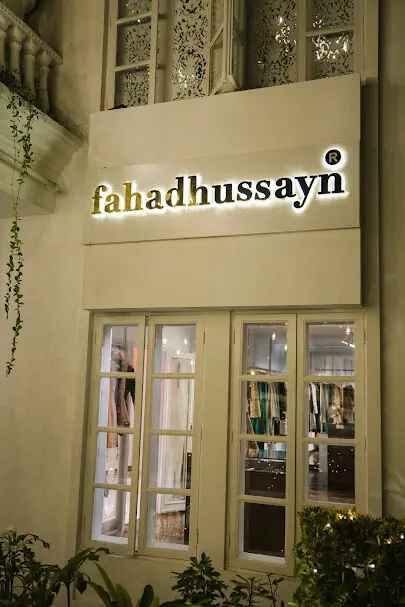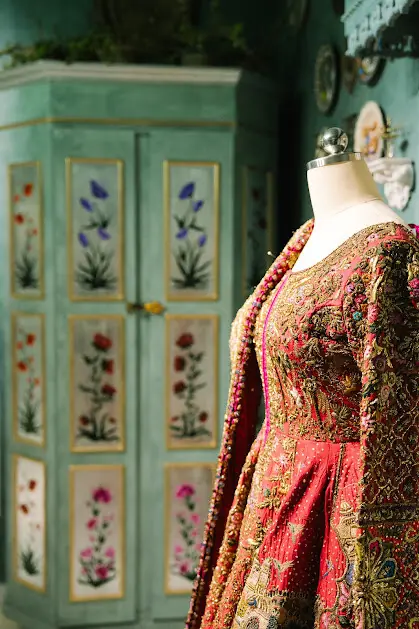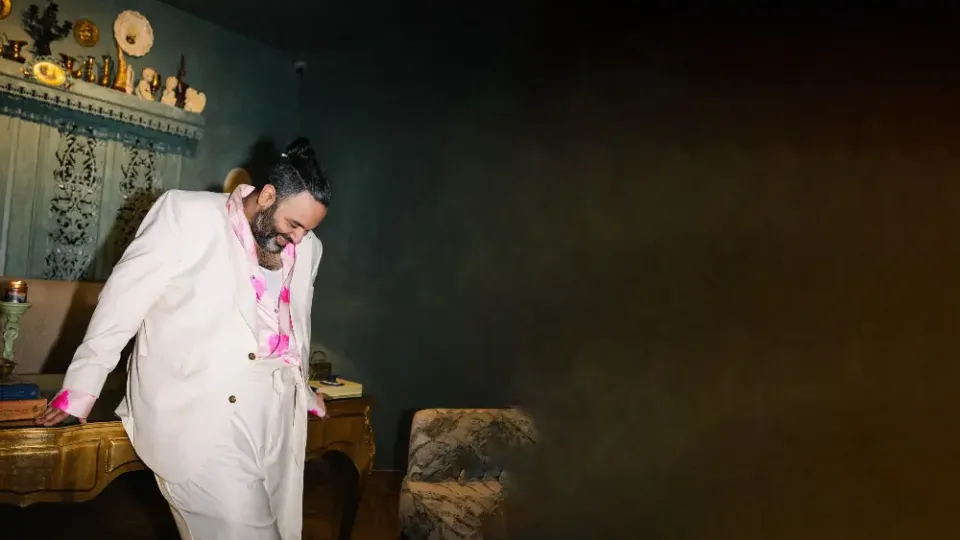October 29, 2025
ISLAMABAD – Fahad Hussayn doesn’t just design clothes — he tells stories, creates worlds, conceives characters.
Inside his imaginarium, winged, colourful birds take to the sky, courtesans whirl in voluminous angarkhas, a baraat [wedding procession] of bejewelled churrails [female demons] carry a golden doli [palanquin] through an enchanted forest, tigers roar against a glimmering night sky, a glassy-eyed putli [puppet] in elaborate bridal-wear tilts unnaturally, a princess roams through a bazaar selling magical itar [perfume], women dance to timeless folk music over a floor covered entirely by rose petals, and men and women walk out on the runway, wearing multi-tiered masks and sequins on their faces.
Music is curated to accompany these stories and entire backdrops — a shahidarbar [royal court], an elaborately carpeted colonial setting, a forest bedecked with marigolds and fairy lights — may be created to add authenticity.
When Fahad Hussayn showcases a collection, he doesn’t just focus on the clothes. He goes the extra mile, planning out little details, and delivers an experience. At a time when Pakistani fashion often gets limited to unimaginative catalogue shoots and lacklustre, repetitive aesthetics are put forward as ‘design’, Fahad makes an effort to create a platform for the designs he has lovingly created.
And while the designer’s 16-year-long career has seen many ups and downs, credit must be given to him for always staying true to his aesthetic and for never compromising on his creativity, even when he is designing a commercial, ‘safe’ collection.

His retail space and studio, the newly opened Fahad Hussayn Academy in Karachi, offers visitors a glimpse into his world. A treasure of precious carpets, vintage plates, sculptures, paintings and wooden carvings line the walls, and one-of-a-kind chandeliers hang from the ceiling. There is a classy office space, an entire room in green, and another lined on all sides by mirrored cupboards holding various designs. There is the couture worked with intricate embroideries, the relatively more economical Print Museum wedding formals, the psychedelic, printed Faction lawn line, the Menagerie line of statement jewellery and a marvellous little line-up of handbags.
The expansion from his home-ground in Lahore to this artisanal space in Karachi is testament to Fahad’s growing business. For those acquainted with his journey, it is also an announcement, loud and clear, that Fahad Hussayn has bounced back.
Some five years ago, weighed down by mismanagement and financial issues, Fahad had announced bankruptcy. It had been unfortunate but not very shocking, since whispers had been filtering out about delayed orders and problems with staff. A year later, he was back in business. At that time, many had questioned whether he would stay afloat this time. Ever since his debut, Fahad had been touted as one of Pakistan’s most promising young names. But marrying craft with commerce isn’t everyone’s ballgame and Fahad had already fumbled once.

He made sure that he didn’t fumble again. The Academy in Karachi — he plans to eventually teach and train young designers in this space, hence the scholastic reference — is only the most recent feather in his cap. He’s been collecting a vibrant array of plumes all through his career!
There have been solo shows, fashion installations, editorial fashion shoots, music videos, red carpet stylings, costume designs for movies, the yearly participation in Hum Network’s Bridal Couture Week (BCW) and, now, this store.
This is what we talk about as we begin our interview.
“It was important for me to make sure that my work was visible after I relaunched,” says Fahad. “I had to set my foot firmly on the ground, let people know that I was back and the business was functional again. So, I worked on a range of projects — and continue to do so now — and invited select media representatives to different fashion installations.”
I observe that he had especially been very clever when organising his installations where, instead of walking on a runway, the models would be dressed in his designs and stand in a curated space. The media representatives and Fahad’s peers from the fashion industry would be invited to roam around and see the designs up-close. Later, once everyone had left — or earlier in the day, before the event — the models would be photographed in detailed shoots.
Fahad nods. “My shoots are usually very grand. I like designing an entire space, with a backdrop and props. And since the models would already have gotten their hair and make-up done and would be wearing the clothes, it made sense to open up the space to a select guest list.”
He adds, “I don’t do this as much now. It can get difficult, with people coming in late and, then, there is also the expenditure of catering to the guests. Also, sometimes I can’t risk disturbing a shoot. For my Alta Moda line, recently, I had to shoot the model in the rain. It had to be done in a timely way — once the outfit got drenched, we couldn’t have quickly shot again — and I couldn’t have people walking about while we photographed.”
He continues: “I choose to show regularly at BCW because it is great for business. A lot of orders come in.”
So, is present-day Fahad Hussayn more business-savvy than his predecessor from some years ago? “Yes, I have restructured, delegated, set some very professional teams in place,” he says.
Recalling the past, he says, “Back then, I would be doing everything myself, from designing to overseeing production to quality control to even, sometimes, handling sales. I was unable to find reliable employees, but didn’t realise that I would not be able to manage if I took on too much workload.
“The staff that I did have stole from me countless times — it could be something as petty as overcharging the amount that had to be paid for deliveries to a robbery of millions, with them taking the payment for an order but never punching it in, and quietly taking the money home. Everything that could possibly go wrong went wrong back then. I couldn’t keep up and had to close down.”
It must have hurt. He agrees. “Yes, adulting and letting go of things that you love always hurts.”
But by the time this happened, he had worked extensively with fashion designers both in Karachi and Lahore. Did the industry offer him support?
“Some support and mostly silence,” he laughs. “One person — that we shall not name — reached out to me and offered to buy my company, provided that I would no longer have anything to do with it. This other major high-street brand met me for interviews three times and then offered me a job with minimal pay. It was a low phase for me, with people trying to tell me that I was not good enough.”

How did he restart his business then?
“I started a job at a textile company and those funds helped me in restarting my business. This time, I restructured everything, setting up an accounts department, a procurement department, and organising a design team that I oversee. My family now co-owns the business with me and helps me run it. After having so many bad experiences with others, I know that my brand is safe with my family.
“I eliminated potential hazards. For instance, our Print Museum Bridals are industrially produced and, if we are asked for customisation, we charge extra for it. And I source our raw materials from easily accessible locations. There was a time when I had considered sourcing fabric from India but there was too much red-tape involved, and I couldn’t risk delays. As it is, even in Pakistan, we are constantly in fight-or-flight mode, dealing with political rallies, road blockages and, sadly, even floods. Expansion in Pakistan is never easy.”
And now, he has expanded to a new brick-and-mortar space. Why did he opt to set up shop in Karachi while he still operates from his studio in Lahore?
“Bridals can’t be sold online easily in Pakistan, although a lot of our international orders are placed online,” he says. “Originally, we had only planned to set up just a bridal studio, but then I found this place and it was beautiful. It had enough space for me to set up racks for Faction and Print Museum.” He adds jokingly: “And I think that I can contribute to the Karachi fashion scene.”
There are often conversations on how customers in Karachi and Lahore have very different aesthetics. Does he agree? “I absolutely disagree! There is no Karachi-Lahore divide in fashion and, as it is, I am from Faisalabad, so I don’t belong to either place. Different customers will have different preferences and they will opt to go to designers that they like. There are customers who like heavy embroideries, others enjoy minimalism, there is a market for vibrant clothes and another for gaudy designs. It isn’t dependent on geographical location.”
Does he feel that his penchant for theatrics may scare off certain customers? Last year, for instance, he planned out an elaborate campaign titled ‘Chhallawon Ki Baraat’, inspired by age-old Punjabi folklore, where a procession of bedecked djinns trooped through a forest, luring commonfolk into their realm and turning them into one of their own. The models’ faces glinted with metallic paint, their eyes were turned entirely white and they wore Fahad Hussayn couture and jewellery. Wasn’t he worried that customers would get spooked away from buying wedding-wear, which was being modelled by make-believe djinns?
“That was an editorial shoot and its purpose was to create talkability,” responds Fahad. “That’s all I wanted and I managed to achieve it. Many of the clothes in the shoot were a mix of separates from different collections and customers coming in to place orders got to see the outfits in their entirety.”
He adds: “I like imagining worlds for my designs but, at the same time, every outfit gets photographed in a standard catalogue shoot against a white background. That’s where the customer can zoom in on the clothes and see the details.”
There are times when he has been criticised for creating too much tamasha [theatrics] with his fashion shows and shoots, taking attention away from his designs. Fahad takes a deep breath and grins — he’s heard this crib before.
“Criticism is always welcome, but I don’t think that this critique is valid. I create beautiful clothes but then I want to showcase them in a certain way. I like to make the show theatrical and I get songs created to accompany the collection. Now, at BCW, the organisers are asking us to pay royalties for the music that we use in our shows. I realised this a long time ago, which is why there is a collection of music that is copyrighted to me. In that capacity, I have also been promoting the music industry.”

So, this critique would be valid only if he felt that his designs were mediocre? He nods. “But that is okay. I feel that, as a unique individual paving a path which is markedly different from those around him, a lot of people feel intimidated by me and may criticise unnecessarily. It is ironic because I have always been supportive of others, collaborating often with talented people just out of goodwill. Offering kindness and support to others is not the norm, but it takes one person to start a revolution.”
Does the criticism and lack of support from peers ever get him down? “It does, I am human,” he admits. “But then I disconnect from the outside world and create something fabulous. I would rather prove people wrong through my work.”
I tell him that I like his Zen state of mind — the Fahad Hussayn I have known over the years would often be tempestuous, and was notorious for his temper tantrums. “I would get angry when I felt that people were being unfair,” he accepts. “I work very hard when I am preparing for a show, planning everything from the clothes to the accessories, to the write-up to the music to creating backdrops for the ramp. And then, when accessories would get lost backstage or the celebrity showstoppers would turn up late or my tailor would rush off in-between an alteration to take selfies with a celebrity, I would lose my cool.”
And he has changed now? “I am trying,” he says. “I will step out for some time and then return when I get less angry. Ideally, I try to work with people who are respectful and professional.”
He often works with celebrities, I observe at this point. He replies, “Yes, and many of them are very talented and add visibility to a collection. I have walked out on sets where celebrities have attitude problems. If it is my own shoot and I have no choice but to execute it, I leave the set for some time and then return once I have calmed down.”
He smiles. “Being known for having a temper is actually not a bad thing. It gets people on their toes and makes them deliver. It can get them to speed up when I get angry and it is 2am in the night so that we can all wrap up and be home before sunrise.”
I have seen models and celebrities flock around him, often working pro bono in his shows and shoots. Fahad says, “Often, they are gravitating not just towards the designer but also the creative director. It’s why director Bilal Lashari has taken me on board as creative director for multiple projects.
“When I curate an image, I don’t just decide on the clothes the model will wear, I decide the make-up, the lighting, the way he or she should pose. Sometimes, I have simply suggested that a model change the shape of her eyebrows, and she has decided to keep them that way. I have an eye, an imagination, and then I know how to execute what I want.” He adds, “I am now learning how to use artificial intelligence and how to use it to push the boundaries of my imagination.”
And he wouldn’t be Fahad Hussayn if he didn’t always want to push boundaries, to innovate, to create new experiences. Pakistani fashion may generally have become generic, with designers toeing commercial lines, but Fahad and his imaginarium offer a silver lining of hope. He reminds you that Pakistani fashion can still be exciting, a little crazy, a little magical, a little awe-inspiring.


